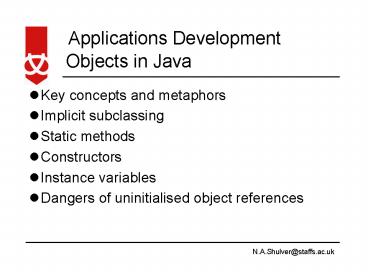Objects in Java - PowerPoint PPT Presentation
1 / 11
Title:
Objects in Java
Description:
... e1 = new Egg('Green'); // create some objects... Egg e2 = new Egg(); // what ... { Egg e1 = new Egg('Green'); // green egg. Egg e2 = new Egg(); // orange egg ... – PowerPoint PPT presentation
Number of Views:77
Avg rating:3.0/5.0
Title: Objects in Java
1
Objects in Java
- Key concepts and metaphors
- Implicit subclassing
- Static methods
- Constructors
- Instance variables
- Dangers of uninitialised object references
2
Metaphors - inheritance
- A small UK company (Watsonian Squire Ltd) imports
Royal Enfield motorcycles from India where they
are still in production - The basic design has not changed substantially
since 1949! - The UK company does two things
- checks the imported bikes and sells them on
directly - or modifies the bikes into Clubman and
Trailie styles by changing some components
3
Metaphors - inheritance
- The company obtains an instance of a basic
motorcycle superclass object and can use it
directly - or it can subclass the object and override a
feature by providing a new or modified part or
function - This would not be possible without the
cooperation of the Indian factory. The style of
the motorcycle is not final.
4
What about a simple object?
- To subclass we do this
- public class Spoon extends Cutlery ..
- But what does this do?
- public class TaxCalcLib
- Any class definition with no explicit extends
clause is inheriting from java.lang.Object - This provides the bare minimum framework for a
class to function
5
Structure of a simple class
- import java.net.
- public class HostName
- public static void main(String args)
- InetAddress iaLocal
- try
- iaLocal InetAddress.getLocalHost()
- System.out.println(Name"
iaLocal.getHostName()) - catch (UnknownHostException e)
- System.err.println("Don't know about local
host") - System.exit(0)
- // end of class HostName
6
Static methods
- Note that the example program is part of an
object called HostName - Thus the filename must be HostName.java
- But how does the object get instantiated?
- Surprise - it doesnt!
- The example uses a static method (code thats
part of the class, not the object)
7
Object instantiation
- public class Egg
- private String myColour
- public Egg(String sEggColour) // NB no return
type! - myColour sEggColour
- public Egg() // NB no return type!
- myColour Orange
- public static void main(String args)
- Egg e1 new Egg(Green) // create some
objects - Egg e2 new Egg() // what colour is this?
- Egg e new Egg6 // no objects created
here! - // end of class Egg
8
Constructors
- A constructor is an initialisation method
- It runs when a new object is created
- A class may define many object constructors
- Each constructor differs only in its input
parameters - All methods can have multiple flavours
- However, unlike other methods, constructors have
no return type
9
- public class Egg
- private String myColour // each instance gets
its own copy - public Egg(String sEggColour)
- myColour sEggColour
- public Egg()
- myColour "Orange"
- public void reportColour()
- System.out.println(myColour)
- public static void main(String args) // static
all eggs share this - Egg e1 new Egg("Green") // green egg
- Egg e2 new Egg() // orange egg
- Egg e new Egg6 // six references to
eggs - //
- e1.reportColour() // should be green
- e2.reportColour() // should be orange
- e0.reportColour() // runtime error no eggs
here yet
10
Comment on the examples
- The idea of using a static method of a class to
instantiate objects of the same type is common
practice (e.g. in small programs, for testing) - It seems counter-intuitive to some people
- A clear separation between the concepts of
- static, class-based code and
- dynamic, object-based code
- helps us gain a better perspective
11
Conclusion
- We have seen
- some of the concepts and language associated with
object-orientation - some practical issues of program structure,
including the use of static methods - constructors and their use































